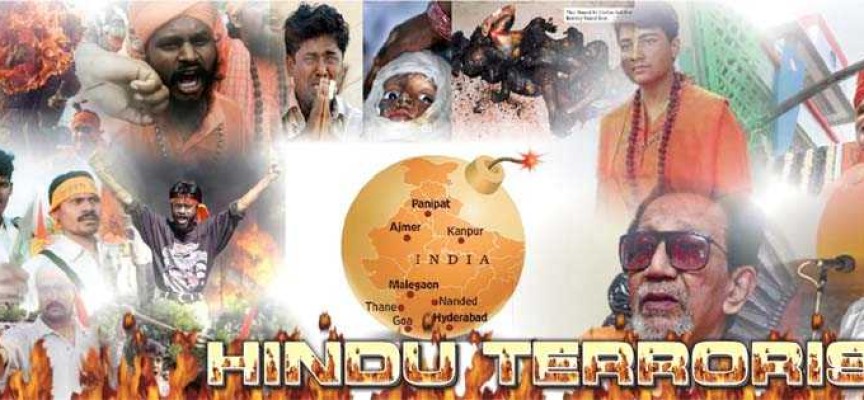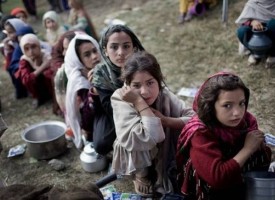The term ‘Hindu Terrorism’ (also known as Saffron Terror) came into the limelight in 2010, when Wikileaks reported a statement by Rahul Gandhi to the US ambassador to India. While talking to the US ambassador, Rahul Gandhi said, “Although there was evidence of some support for Lashkar-e-Taiba among certain elements in India’s indigenous Muslim community, the bigger threat may be the growth of radicalized Hindu groups, which create religious tensions and political confrontations with the Muslim community.”
The concept of Hindu terrorism is not a figment of imagination nor is it mere propaganda by the media. According to a report by the Congressional Research Service (CRS), an independent and bipartisan wing of the US Congress, “Thus did ‘Hindu terrorism’ became a new and highly controversial phrase in India’s national dialogue,…Many Indian observers warned of the danger of a ‘militant majoritarianism’ among Hindu nationalists that threatens to rend the secular fabric of the nation.”
“What do we make of the war-cry pehle kasai, phir isai: first the butchers (Muslims), then the Christians?” writes Kapil Komiredd in Guardian (India must face up to Hindu terrorism)
Famous Indian journalist Barkha Dutt grills politicians about rising Hindu terrorism.
The History of Hindu Terrorism
Long before there were ‘Muslim terrorists’, the concept of ‘Hindutva’ was conceived, which means Hinduness. This term came into being in the late 1923 and was propagated by Hindu nationalists to support the idea of ‘Akhand Bharat’ or “Greater India’. It advocates Hindu nationalism and is supported by organizations like the Rashtriya Swayamsevak Sangh (RSS), Bharatiya Janata Party (BJP), Bajrang Dal, and the Vishwa Hindu Parishad. According to Veer Savarkar, the person who coined the term of Hindutva, “…Hindutva is not a word but a history. Not only the spiritual or religious history of our people as at times it is mistaken to be…., but a history in full….Hindutva embraces all the departments of thought and activity of the whole Being of our Hindu race.”
The origins of Hindu terrorism as a result of propagation of the Hindutva philosophy can be traced back to the pre-partition India. In his memoirs, “A Life of Our Times”, Rajeshwar Dayal, the Chief Secretary of Uttar Pradesh at the time of Partition, says, “Damning evidence of RSS chief Golwalkar’s plans to conduct a pogrom against Muslims.”
In addition to this, several commissions setup by the Indian government have highlighted the involvement of Hindu extremist groups in terrorist attacks. These commissions include the Reddy Commission for Gujrat riots in 1969, the Madon Commission on riots in early 1970’s and the Justice Vithayathil Commission that investigated the 1971 Tellicherry riots. The reports of all of these commissions provide strong evidence of involvement of Hindu extremists groups like the RSS, in terror attacks.
Official Confession of ‘Hindu Terrorism’
Proof of Hindu Terrorism against Sikhs
Is It Real?
A report released by the CRS in 2011, states, “Even more recent are overt signs that India is home to militant Hindu nationalist groups intent on launching domestic terrorist attacks.”
The involvement of Swami Aseemanand, a former RSS activist in the terror attacks on Ajmer Sharif, Mecca Masjid, Malegaon blasts and Samjhauta Express bombings is enough to open our eyes towards Hindu terrorism. “In late 2010, Hindutva extremist Swami Aseemanand confessed to involvement in a number of terrorist attacks previously blamed on Islamist militants, including the 2006 bombing of a Muslim cemetery in Malegaon that killed 37 people and the 2007 bombing of the trans-border Samjhauta Express, a train linking Delhi and Lahore, Pakistan, that killed 68 people, most of them Pakistani civilians,” says the CRS report.
According to the Indian National Investigation Agency (NIA), “Aseemanand not only provided financial and logistical support to the terror group which executed this dastardly act but also played a vital role in instigating and motivating his associates to undertake this terrorist act.”
Hindu attack on minorities
Indian government in denial about Saffron Terror
The True Colors of Hindu Terrorism
Samjhauta Express bombing: On 18 February, 2007, Samjhauta Express en route to Lahore from Delhi, was rocked by powerful bomb blasts. It resulted in 68 casualties and scores injured. Most of the passengers killed in this terrorist attack were Pakistani nationals. The attacks were initially linked to a Hindu fundamentalist group, Abhinav Bharat. Afterwards, an Indian army officer, colonel Purohit was implicated and then an RSS activist, Swami Aseemanand confessed to these and several other terrorist attacks.
Malegaon blasts (2008): On 29 September 2008, two bombs exploded in Malegaon, Maharashtra, killing 7 people and injuring many. The police arrested three Hindu extremists, Sadhvi Pragya Singh Thakur, Shiv Narayan Gopal Singh Kalsanghra and Shyam Bhawarlal Sahu.
NDTV presents the proof of involvement of Hindu extremists in Malegaon and Ajmer blasts
Mecca Masjid bombing: Fourteen people were killed when a bomb went off inside the Mecca Masjid in Hyderabad. According to the National Investigation Agency (NIA), Central Bureau of Investigation (CBI) and Anti Terrorist Squad (ATS), former members of the RSS were responsible for this terrorist activity.
An appalling video of the Gujarati riots in 2002
Violence against Christians: Muslims are not the only target of Hindu extremists; other religious minorities are also at the receiving end. According to The United States Commission on International Religious Freedom, an independent agency advising the Administration and Congress, “Today, according to estimates, thousands of Christians in the eastern state of Orissa are in hiding in jungles and refugee camps as mobs associated with Hindu nationalist organizations continue a three week long series of acts of violence and arson directed against Christian-owned properties, including churches…The current violence in Orissa represents the second major outbreak of religious violence in Orissa since December, and is estimated to have killed at least 26 individuals, and destroyed about 3,000 Christian homes and 134 places of worship. There are also new reports of attacks against Christians and church properties in several southern states, including Karnataka and Kerala.”
Hindu Persecution of Christians
Hindu Radicals Attack Christians
Sikh Genocide
The Indian government needs to take a close, hard look at its policy of denying the existence of home-grown terrorism of Hindu extremists. If there was any doubt, a statement by a member of a Special Investigating Team (SIT) of India’s Central Bureau of Investigation published in the times of India on Sunday July 14, 2013, is enough to see the real picture. The former Asst. Secretary of Indian ministry of Interior R.V.S. Mani accused the Indian government of plotting and executing the terror attack on Indian Parliament and the 2008 Mumbai attacks.








Conspiracy theorists
No wonder India stands as the country with longest history of religious intolerance. Now augmented with horrible crimes such as rape, I thank God for Pakistan’s existence.
May Allah Bless Muslims